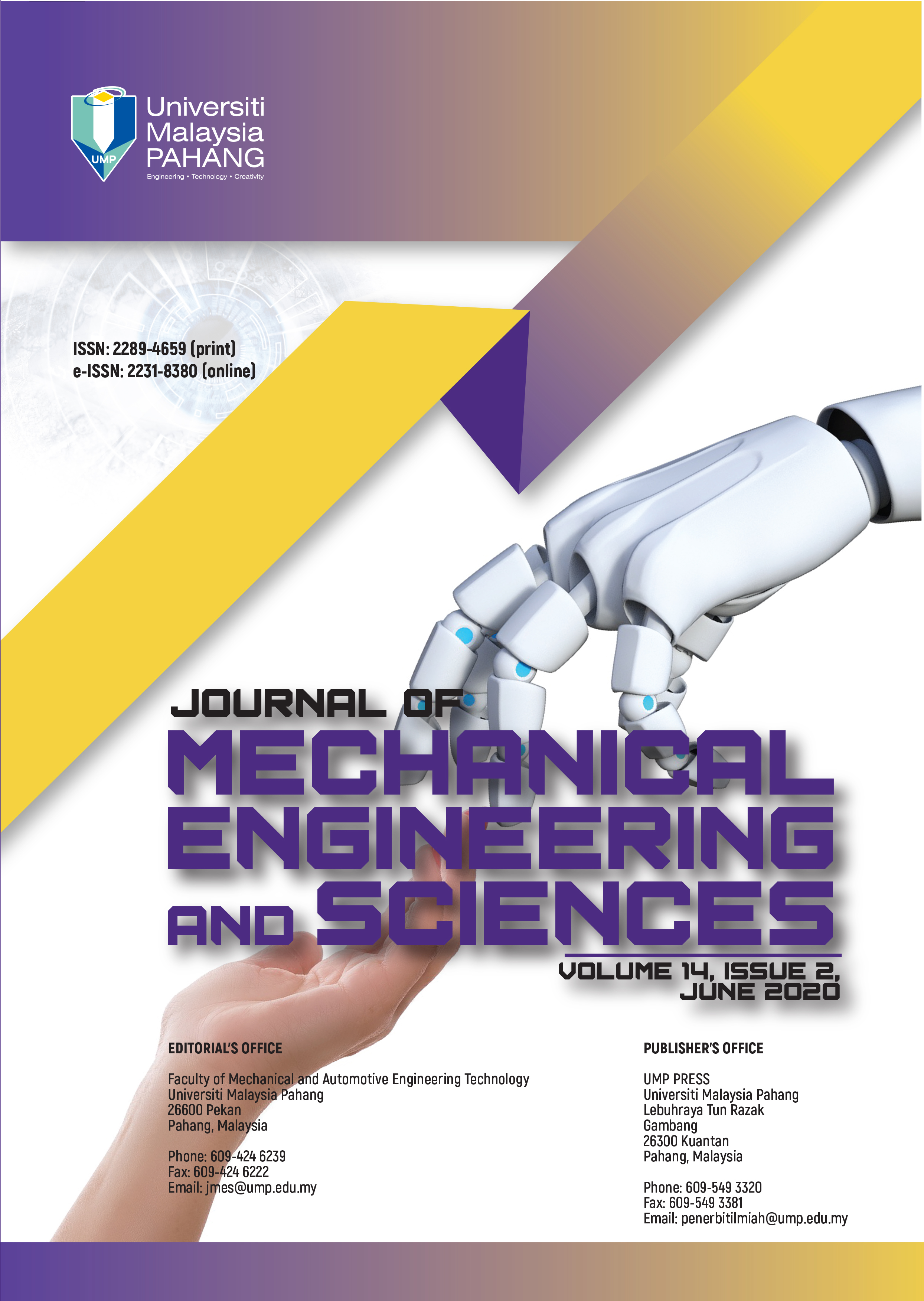Micromechanical modeling of ductile fracture of human humerus
DOI:
https://doi.org/10.15282/jmes.14.2.2020.32.0544Keywords:
Micromechanics, biomechanics, multiscale modeling, fracture, impact, finite elementAbstract
This paper deals with the formulation, development and validation of a newly developed micromechanical-based model for the modeling of the nonlinear ductile fracture of human humerus. The originality of the present works concerns the coupling between the micromechanical formulation based on the Mori-Tanaka homogenization scheme for cylindrical voids and the Marigo nonlinear ductile damage model based on the porosity growth. The proposed model was implemented as a User Material UMAT within the explicit dynamic software LS-DYNA and validated by numerical and experimental analysis conducted by a drop tower impact of human humerus. The outcome of the proposed multi-scale model appears to correctly predict the general trends observed experimentally via the good estimation of the ultimate impact load and the fracture patterns of the human humerus.
References
A. Linder and W. Svedberg, “Review of average sized male and female occupant models in European regulatory safety assessment tests and European laws: Gaps and bridging suggestions,” Accid. Anal. Prev., vol. 127, no. 1, pp. 156–162, 2019.
S. Duma, P. Schreiber, J. McMaster, J. Crandall, C. Bass, and W. Pilkey, Dynamic injury tolerances for long bones of the female upper extremity. Gothenburg, Sweden: IRCOBI Conference, 1998.
M. Van Eijnatten, R. Van Dijk, J. Dobbe, G. Streekstra, J. Koivisto, and J. Wolff, “Inv CT image segmentation methods for bone used in medical additive manufacturing,” Med. Eng. Phys., vol. 51, pp. 6–16, 2018.
W.I.I Wan Iskandar Mirza, M.N Abdul Rani, M.A Yunus, R. Omar, and M.S Mohd Zin, “Alternative scheme for frequency response function measurement of experimental-analytical dynamic substructuring,” J. Mech. Eng. Sci., vol. 13, no. 2, pp. 4946-4957, 2019.
C. Hellmich, J. Barthelemy, and L. Dormieux, “Mineral-collagen interactions in elasticity of bone ultrastructure - a continuum micromechanics approach,” Eur. J. Mech. A Solids, vol. 23, pp. 783-810, 2004.
O. Sam Daliri, M. Farahani, and M. Farhang, “A combined numerical and statistical analysis for prediction of critical buckling load of the cylindrical shell with rectangular cutout,” Eng. Solid Mech., vol. 7, pp. 35-46, 2019.
O. Sam Daliri, and M. Farahani, “Characterization of Stress Concentration in Thin Cylindrical Shells with Rectangular Cutout Under Axial Pressure,” Int. J. Adv. Manuf. Tech., vol. 24, no. 3, pp. 133–141, 2017.
F. Golesorkhie F, and M. Navi, “Effects of geometric variations on buckling properties of carbon nanostructures: A finite element analysis,” J. Mech. Eng. Sci., vol. 14, no. 1, pp. 6473–6487, 2020.
A. Geromel Fischer, and J.J Marigo, “Gradient damage models applied to dynamic fragmentation of brittle materials,” Int. J. Frac., 2019, doi: 10.1007/s10704-019-00356-y.
S. Lurie, Y. Solyaev, and K. Shramko, “Comparison between the Mori-Tanaka and generalized self-consistent methods in the framework of anti-plane strain inclusion problem in strain gradient elasticity,” Mech. Mater., vol. 122, pp. 133–144, 2018.
J. Rahmoun, A. Auperrin, R. Delille, H. Naceur, and P. Drazetic, “Characterization and micromechanical modeling of the human cranial bone elastic properties,” Mech. Res. Commun., vol. 60, pp. 7–14, 2014.
H. Naceur, J. Rahmoun, J. Halgrin, and P. Chabrand, “F Multiscale finite element modeling of ductile damage behavior of the human femur under dynamic loading,” Int. J. Damage Mech., vol. 24, no. 3, pp. 313-337, 2014.
M. Murugesan, and D. W Jung, “Johnson Cook Material and Failure Model Parameters Estimation of AISI-1045 Medium Carbon Steel for Metal Forming Applications,” Materials, vol. 12, no. 4, pp. 609, 2014, https://doi.org/10.3390/ma120406093683.
LSTC.LS-DYNA R11, “Edition: Livermore Software Technology Corporation I,” Keyword User's manual, 3186 pages, Livermore, California, 2018.
Q.Z Zhu, J.F Shao, and D. Kondo, “A micromechanics-based thermodynamic formulation of isotropic damage with unilateral and friction effects,” Eur. J. Mech. A Solids, vol. 30, no. 3, pp. 316–325, 2011.
R.A Hill, “consistent mechanics of composite materials,” J. Mech. Phys. Solids, vol. 13, pp. 213-222, 1965.
J. Rahmoun, F. Chaari , E. Markiewicz, and P. Drazetic, “Micromechanical modeling of the anisotropy of elastic biological composites. Multiscale Modeling and Simulation,” Multiscale Model Sim., vol. 8, no. 1, pp. 326–336 2009.
A.V Sobolev M.V Radchenko, “Use of Johnson-Cook plasticity model for numerical simulations of the SNF shipping cask drop tests,” J. Nucl. Sci. Technol., vol. 2, no. 4, pp. 272-276, 2016.
Dassault Systemes, “CATIA V6 User's Guide,” 3D CAD Design Software, Vélizy-Villacoublay, France. 2013.
Altair Engineering, “Hypermesh 2017 Reference Guide,” Copyright 1986-2016 Altair Engineering Inc, 4968 pages, 1820 East Big Beaver Road. Troy, MI 48083, United States. 2017.
H. Naceur, S. Shiri, D. Coutellier, J.J Batoz, “On the modeling and design of composite multilayered structures using solid-shell finite element model,” Finite Elem. Anal. Des., vol. 70, pp. 1–14, 2013.
P.K Zysset, X. Edward Guo, C. Edward Hoffler, K.E Moore, and S.A Goldstein, “Elastic modulus and hardness of cortical and trabecular bone lamellae measured by nanoindentation in the human femur,” J. Biomech., vol. 32, no. 10, pp. 1005-1012.
V. Baca, Z. Horak, P. Mikulenka, and V. Dzupa, “Comparison of an inhomogeneous orthotropic and isotropic material models used for FE analyses,” Med. Eng. Phys., vol. 30, pp. 924–930, 2008.
L. Peng, J. Bai, X. Zeng, and Y. Zhou, “Comparison of isotropic and orthotropic material property assignments on femoral finite element models under two loading conditions,” Med. Eng. Phys., vol. 28, no. 3, pp. 227-233, 2006.
L.J Jia, W. Fujie, T. Ikai, S. Yochida, and H. Ge, “Jia L-J, Fujie W, Ikai T, Yochida S, Ge H,” Eng. Fract. Mech., vol. 215, pp. 117-137, 2019.
M. Korgesaar, and J. Romanoff, “Influence of mesh size, stress triaxiality and damage induced softening on ductile fracture of large-scale shell structures,” Mar. Struct., vol. 38, pp. 1–17, 2014.
S. Reddy Vempati, K. Brahma Raju, K. Venkata Subbaiah, “Simulation of Ti-6Al-4V cruciform welded joints subjected to fatigue load using XFEM,” J. Mech. Eng. Sci, vol. 13, no. 3, pp. 149–156, 2019.
Downloads
Published
Issue
Section
License
Copyright (c) 2020 The Author(s)

This work is licensed under a Creative Commons Attribution-NonCommercial 4.0 International License.






